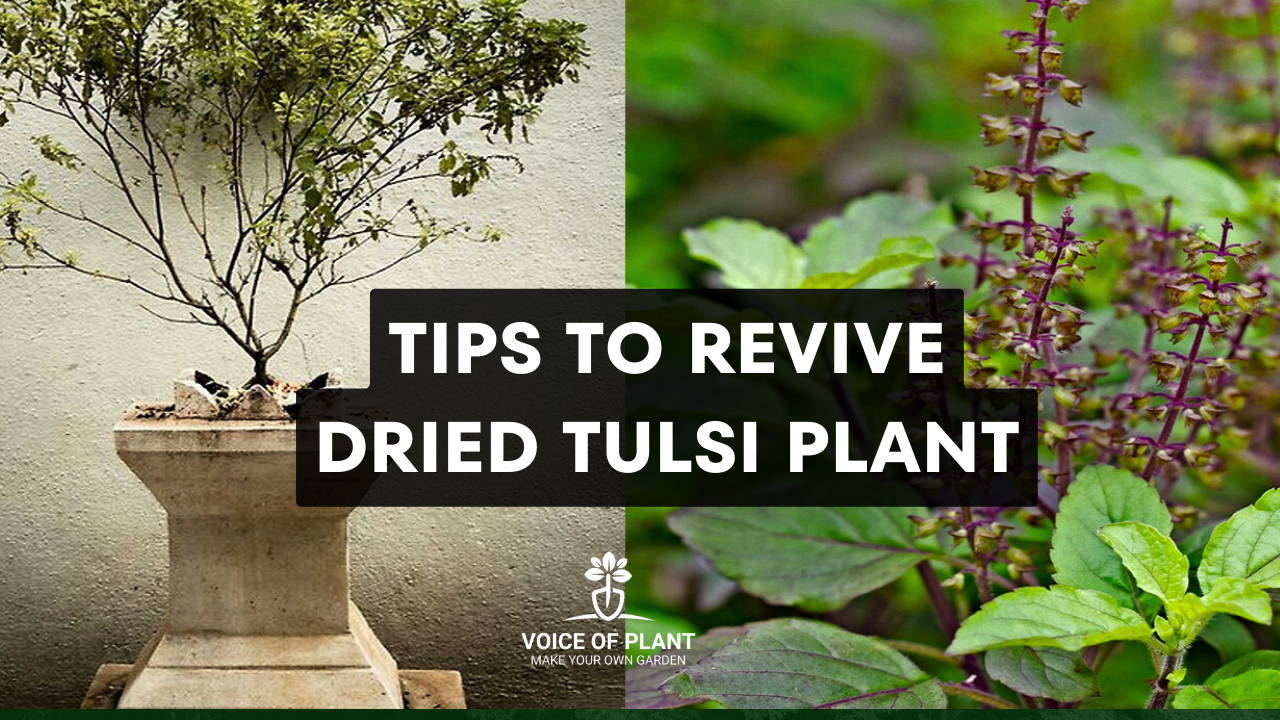How to Revive a Dried Tulsi Plant
During the winter season, our Tulsi (Holy basil) plant enters a dormancy period, causing its leaves to wither and turn yellow. They do not receive adequate sunlight and warmth to grow well. Our Tulsi (basil) plant dries up causing concern about how to revive it.
What can be done to bring back its vibrant green color? Sometimes, in our efforts to help it grow, we unknowingly over-fertilize it, over-water it, and even prune it without understanding it, all of which can end up damaging our Tulsi (basil) plant.
Now that spring has arrived, it is time to care for your Tulsi plant to make it bushy and healthy.
In this article, we will explore effective methods to ensure your Tulsi plant thrives during the spring season without the risk of overfertilization or improper care.
How to Revive a Dried Tulsi Plant
Understanding the Needs of Tulsi
Tulsi, or Holy Basil, requires specific conditions to flourish:
- adequate watering,
- sufficient sunlight, and
- well-draining soil are essential for its growth.
Assessing the Plant’s Condition
When it comes to reviving a dried Tulsi plant, the first step is crucial – assessing its condition. Look closely for any signs of life.
Healthy Tulsi plants exhibit vibrant green stems and leaves, and you may notice new growth emerging from the soil.
- However, if the stems appear dry and brittle, or the leaves are withered and brown, immediate intervention is necessary.
Methods to Revive a Dried Tulsi Plant
1. Pruning Techniques
- Regular pruning is crucial for shaping your Tulsi plant and encouraging new growth.
Tulsi plant primarily grows from its tips, so pruning or plucking from the tip stimulates the emergence of 2-3 new shoots, leading to the development of new branches and leaves.
If your plant is relatively new, around 6 or 3 months old, it’s best to stick to light pruning.
From February to October, regular light pruning can be performed to encourage new branch growth, but avoid harsh pruning.
- After new stems emerge, wait until they reach a length of 5-6 inches before further pruning.
- Hard pruning of Tulsi plant should be reserved for the month of February (during spring season).
For plants that are one or two years old, hard pruning can be quite beneficial.
- By removing yellow leaves, dead, or leggy stems, you encourage the plant to grow more branches and denser foliage. This type of pruning helps maintain the plant’s shape and promotes healthier growth overall.
- After hard pruning, add vermicompost into the soil.
- Avoid using heavy fertilizers as the plants are currently leafless.
Important note:
- Perform hard pruning of your plant only in the evening and keep it shaded for at least 7 days until new leaves emerge.
- This will assist the plant in adapting to its new environment more effectively.
2. Change pot and add compost in the soil
(i) For plants that are one or two years old, it is advisable to consider changing the pot if the roots are bound. Till the soil and add vermicompost to promote improved growth.
(ii) However, if your plant is relatively new, around 6 or 3 months old, there is no need to change the pot. Simply tilling the soil and adding vermicompost will suffice to promote healthy growth.
Important note:
- Only repot your plant in the evening and keep it shaded for 3 to 4 days afterward as it may experience stress. This will help the plant adjust to its new environment more easily.
|
Must read: How to grow & care Tulsi plant |
Adjusting Watering Techniques
Maintain a proper balance between watering and drainage.
- Overwatering can lead to root rot, while underwatering can cause stunted growth.
- Make sure there is adequate drainage to avoid waterlogging, especially for plants grown in containers.
Sunlight for Tulsi plant
Sunlight plays a vital role in the growth and development of Tulsi plants.
- To revive a dried specimen, it is crucial to provide adequate sunlight.
- Choose a location that receives 5 – 6 hours of sunlight daily, preferably outdoors in a sunny spot.
- Proper sunlight exposure helps stimulate photosynthesis and encourages healthy foliage.
Protecting from Cold Conditions
During colder months, protecting Tulsi plants from harsh weather conditions is imperative.
Exposure to frost or chilly temperatures can cause further stress to a struggling plant. Consider bringing potted Tulsi indoors or providing a protective covering, such as a frost cloth or greenhouse.
- This shields the plant from the elements while allowing it to thrive in a controlled environment.
Monitoring for Pests and Diseases
Pests and diseases can wreak havoc on a weakened Tulsi plant, hindering its revival efforts.
- Regular monitoring is key to identifying any signs of infestation or infection promptly.
- Look out for common pests like aphids, spider mites, or fungal diseases such as powdery mildew.
- If detected, take swift action using organic methods (neem oil solution spray) to mitigate damage and restore the plant’s health.
Best Fertilizers for Tulsi Plant
During summer, if fertilizers are used for other plants, you can use chemical-free options like “Cow-dung liquid fertilizer” or “Vermicompost” once a month.
- Ensure cow dung is decomposed to prevent pest issues.
|
Must read: How to grow Tulsi Plant from Seeds |
Conclusion: Reviving Your Dried Tulsi Plant
In conclusion, reviving a dried Tulsi plant requires patience, diligence, and proper care.
- By assessing the plant’s condition, trimming away dead parts, adjusting watering techniques, providing adequate sunlight, protecting from cold conditions, and monitoring for pests and diseases, you can breathe new life into your beloved herb.
Remember to be gentle yet thorough in your approach, allowing the plant time to recover and flourish once again.
Follow our Social media channel:
1. Voice of Plant – YouTube Channel
2. Voice of Plant Facebook Page
3. Instagram Voice of Plant Channel
Happy Gardening!
Make Your Own Garden!
